Broken Bones and Fractures
At the Animal Clinic of Billings and Animal Surgery Clinic, we see dogs and cats with a variety of orthopedic conditions almost every day. If your dog or cat is favoring one leg over another, either continuously or intermittently, there may be a problem with his or her joints. Sudden limping, difficulty in standing up, slower than normal movement, pain, swelling or if the appearance of the leg itself seems unusual could indicate a broken bone or torn ligament in your dog. Some dogs and cats require orthopedic surgery to correct congenital (genetic or hereditary) problems they are born with, not caused by an injury. However, many of these problems can be fixed with surgery.
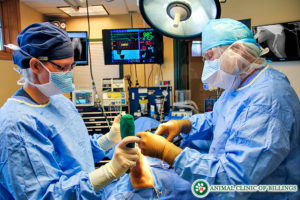
If your dog or cat has a broken leg, a broken back or some other severely broken bone or fracture, our orthopedic surgeons at the Animal Clinic of Billings and Animal Surgery Clinic are here to help! Many of the surgical procedures performed by Dr. Brown and Dr. Flamme at the Animal Clinic of Billings and Animal Surgery Clinic on any given day can be among the most advanced and cutting-edge veterinary surgical procedures. Certification to perform many of these operations requires specialized training after veterinary school and specialized equipment.
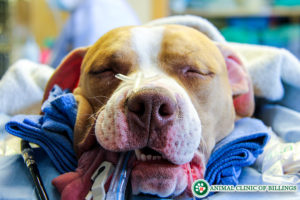
Many dogs and cats will need surgery at least once in their lifetime. As caring pet owners, we want our canine and feline companions to receive the best veterinary surgical care possible in a safe, comfortable environment. The Animal Surgery Clinic of Billings understands these concerns. Our facility features a state-of-the-art modern surgical suite. Our doctors perform all types of surgical procedures with top of the line anesthetic monitoring equipment to ensure our patient’s safety and comfort are of the utmost importance.
Trauma, such as jumping off a ledge or being hit by a car are common reason for broken bones in dogs and cats. Additionally, aggressive bone cancers that destroy the bone from within are not uncommon. When orthopedic surgery is necessary to repair a fracture, torn ligament, muscle, ruptured joint or another form of a broken bone, it is because the injury is too complex to heal naturally with a good result. In many cases, broken bones and complex orthopedic conditions will require substantial support to maintain proper alignment and achieve long-term success. Orthopedic surgical intervention can give a dog or cat the ability to regain use of a limb or other body part that otherwise wouldn’t be possible.
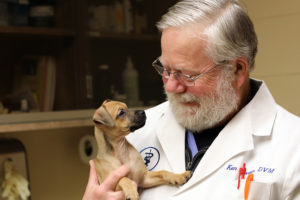 Doctors Brown, Flamme, and Albrecht have more than 65 years of combined veterinary practice experience and have successfully managed thousands of complex orthopedic injuries.
Doctors Brown, Flamme, and Albrecht have more than 65 years of combined veterinary practice experience and have successfully managed thousands of complex orthopedic injuries.
Drs. Brown, Flamme, and Albrecht provide arthroscopic joint surgery, advanced ACL and CrCL injury procedures in Billings, including TPLO and TTA, partial and complete joint fusions, elbow dysplasia surgeries including PAUL, and CUE, total hip replacements, advanced limb straightening procedures in addition to many other advanced forms of spine surgery, knee surgery, shoulder surgery, pelvic fracture surgery, bone grafting, and torn or ruptured ligament repair procedures at the Animal Clinic of Billings.
ADVANCED ORTHOPEDIC AND SPINE SURGERY
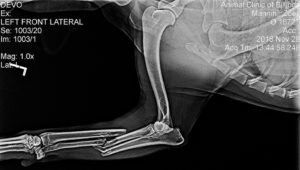
Veterinary orthopedic surgery describes any surgical procedure that repairs broken bones, spines, muscles, joints, or torn ligaments. The objective of every orthopedic surgery procedure is to align broken bones back to where they should be and then pin or hold them in place firmly, to prevent any further movement, so that healing can take place and be done correctly.
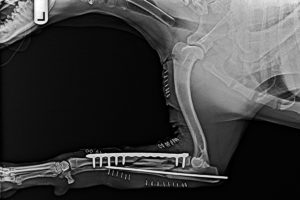 If a dog or cat has a broken bone or other orthopedic condition or injury, orthopedic surgery is the most effective way to correct and manage the affected bone, joint, muscle, spine, or ligament. In most cases, orthopedic surgery is the only way an affected dog or cat can hope to regain mobility and function from the injury and return to a normal state of health.
If a dog or cat has a broken bone or other orthopedic condition or injury, orthopedic surgery is the most effective way to correct and manage the affected bone, joint, muscle, spine, or ligament. In most cases, orthopedic surgery is the only way an affected dog or cat can hope to regain mobility and function from the injury and return to a normal state of health.
Orthopedic surgery, in general, uses surgical procedures to bring damaged or dysfunctional limbs, joints, ligaments, and tendons back to a normal or near normal state when operable. Our surgeons achieve this with the use of surgical implants, including pins, screws, bone plates, external and internal fixation, casts, splints, bone grafting, and other forms of artificial support systems.
What to expect during your dog or cats orthopedic surgery
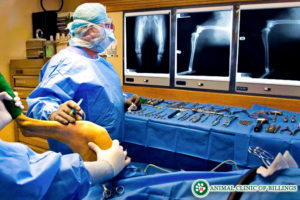
If we schedule your dog for orthopedic surgery, your dog will require heavy sedation, anesthesia, and supplementary oxygen. Before surgery, we will need to run blood tests and thoroughly examine your dog to ensure he or she is healthy enough for surgery and establish the safest type of anesthesia required for your dog.
Before surgery, radiographs (X-Rays) are taken both of the fracture site, and the opposite limb for comparison. Your veterinary surgeon will use the X-Rays to decide the best course of action, surgical procedure, and if necessary, implant type(s) to repair the fracture, including the size of plates, pins, or screws required.
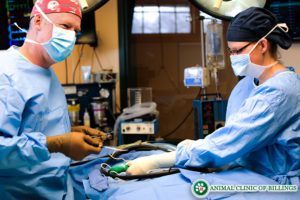
In many cases involving major trauma, critically injured patients will require additional precautionary tests and procedures before or leading into orthopedic surgery. For example, patients who have incurred major trauma to the chest or abdomen, head, and urinary tract.
Leading into surgery, your dog will receive a general anesthetic, and the area surrounding the fracture is shaved and sterilized. Under strict aseptic conditions, your surgeon incises over the fracture site and dissects down to visualize the broken bones.
Different techniques are required for different procedure types, but the general rule is to put all of the broken bones back in the place where they’re supposed to be and immobilize the fractured pieces of the bone so that they cannot move against each other. This includes preventing any slippage of the fracture ends and also stopping any rotation around an implant.
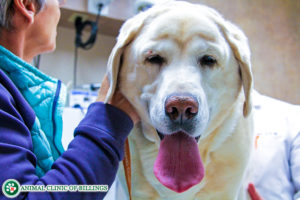 Intraoperative X-rays are performed on fracture repair surgeries prior to surgical wound closure to ensure an optimal position of the bones and implants have been achieved. The fracture site is lavaged with sterile saline before closure, and a local anesthetic may be instilled to reduce postoperative pain.
Intraoperative X-rays are performed on fracture repair surgeries prior to surgical wound closure to ensure an optimal position of the bones and implants have been achieved. The fracture site is lavaged with sterile saline before closure, and a local anesthetic may be instilled to reduce postoperative pain.
Follow-up x-rays are taken to establish the repair is good, the operation site closed with skin sutures, and the patient is allowed to wake up in a comfortable resting site.
Some common types of orthopedic surgery procedures our veterinary surgeons routinely perform at the animal clinic of billings and animal surgery clinic include:
- Advanced Osteotomy for ALD Limb Straightening
- Anterior Cruciate Ligament repair (ACL, CrCL or CCL)
- Bone Grafting
- Carpal Hyperextension / Arthrodesis Joint Fusions
- Diagnostic and Surgical Arthroscopy
- Femoral Rear Limb Head and Neck Ostectomy (FHO)
- Hemilaminectomy Spinal Surgery
- Lumbosacral Stenosis & Spine Disease Correction (LS)
- Proximal Abducting Ulnar Osteotomy (PAUL)
- Tarsal Arthrodesis Joint Fusions (Complete and Partial)
- Tibial Plateau Leveling Osteotomy (TPLO)
- Tibial Tuberosity Advancement (TTA)
- Total Hip Replacement (THR)
- Triple Pelvic Osteotomy (TPO)
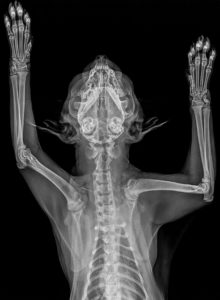 DOG AND CAT BONES
DOG AND CAT BONES
The skeletal system is the body’s structural foundation that enables muscle movement and motion. The word “bone” is often thought of as just arm and leg bones, such as the tibia (shin), femur (thigh), humerus (upper arm), and radius (forearm). Bones account for so many more body parts than that however, including the hips, ribs, spinal vertebrae, skull, shoulders, and tail to name a few. Differently than humans, spinal vertebrae extend down into the tip of the tail in dogs and cats, and male dogs even have a bone inside their penis.
All bones consist of an outer, hard portion known as the cortex and an inner, spongy part known as the medullary cavity or marrow. The outside surface of the cortex is surrounded by a fibrous capsule called the periosteum, which contains blood vessels and nerves. The periosteum also contains immature cells that grow into osteoblasts, which are the cells involved in bone growth, bone healing and fracture repair.
COMMON TYPES OF DOG AND CAT BONE FRACTURES
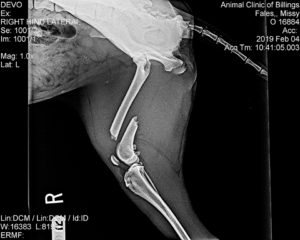 Not all fractures are created equal. There are many types of broken bones and fractures that a dog can sustain, and the type of surgery needed to repair them is variable dependent. In general, bones are calcium-rich, which makes them hard and resilient, but unfortunately also breakable. In addition to a dog or cats age, general health and fracture location, the severity, complexity, and force of impact all play a crucial role in how to manage orthopedic injuries and conditions.
Not all fractures are created equal. There are many types of broken bones and fractures that a dog can sustain, and the type of surgery needed to repair them is variable dependent. In general, bones are calcium-rich, which makes them hard and resilient, but unfortunately also breakable. In addition to a dog or cats age, general health and fracture location, the severity, complexity, and force of impact all play a crucial role in how to manage orthopedic injuries and conditions.
HAIRLINE FRACTURES
Hairline fractures are considered the simplest type of bone fractures. Hairline fractures occur when the bone is still intact, and minimal cracks run up the middle of long bones such as a leg bone. Hairline fractures are easily manageable in dogs and rarely cause misalignment or displacement of the bone. You can think of it like a small crack running up the center of a piece of lumber. Although the board itself might still be intact, it’s structural integrity to bare weight has been compromised and will continue to stray.
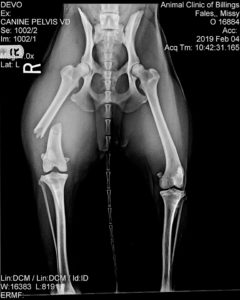 MULTIPLE-PIECE FRACTURES
MULTIPLE-PIECE FRACTURES
Stronger impacts can sometimes cause the bone to shatter into multiple pieces. These types of fractures are much more complicated and almost always require proper surgical intervention.
JOINT FRACTURES
When a dog fractures a joint, the injury is even more severe. Because of the enormous roll joints play in movement, joint fractures can lead to arthritis long after the bone has healed.
OPEN OR COMPOUND FRACTURES
Fractures in which the bone becomes exposed outside of the dog’s skin are called “open” or “compound” fractures. These are severe fractures where sharp pieces of bone can pierce surrounding tissues and damage tendons, muscles, nerves, and blood vessels. Additionally, when a bone is exposed outside the dog’s body, it is likely to become dirty and contaminated. This can lead to severe infections that can become life and limb threatening and require very proper care to resolve.
Common orthopedic conditions we manage regularly
Almost every fracture and orthopedic injury will have a surgical or other management solution. Most orthopedic cases may have several possible acceptable treatments. No matter how bad the condition may seem, Drs. Brown and Sherburne at the Animal Clinic of Billings and Animal Surgery Clinic are skilled in many different fracture repair methods and will employ the most practical, safe, and effective surgical techniques for your dog or cat. These may involve minimally invasive procedures, which are less aggressive surgical approaches and lessen the discomfort your dog or cat experiences and helps quicken the rate of healing.
We offer many types of fracture repair, stabilization, and management options, including:
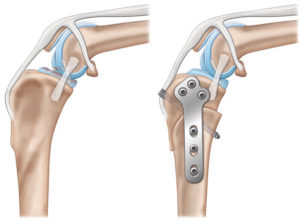 TPLO Surgery
TPLO Surgery
TPLO Surgery (Tibial Plateau Leveling Osteotomy), TTA (Tibial Tuberosity Advancement), and extracapsular repair are standard orthopedic procedures we offer for all breeds of dogs. Our most commonly performed orthopedic procedure, the TPLO surgery stabilizes the knee by leveling the tibial plateau. A TPLO surgery was developed to stabilize the knee by altering the biomechanics of the knee, so the dog no longer needs the damaged CrCL (ACL or CCL). Our surgeons do this by reorienting the tibia, or the bone that makes up the lower portion of the knee joint. Dogs have a sloped tibia bone, meaning the femur can slide off the back of the tibia as a dog bears weight on the limb if the CrCL is ruptured or damaged. A TPLO surgery levels this slope, and helps to prevent instability within the joint by allowing the dog to comfortably bear weight on the limb.
Cruciate Ligament Repair (ACL, CrCL, CCL)
Torn, damaged and ruptured Cranial Cruciate Ligaments (ACL, CrCL, CCL) and Cruciate ligament disease in dogs are the most common orthopedic injuries we surgically treat at the Animal Clinic of Billings and Animal Surgery Clinic. We offer ACL, CrCL or CCL extracapsular repair for all breeds of dogs and cats.
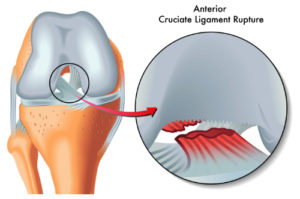
The repair choice depends on the type of injury and what’s best for the individual dog or cat. Our doctors provide comprehensive case management from start to finish and offer many additional services, including laser therapy and physiotherapy (PRT) consultations to reduce recovery time and assist with pain management.
Elbow Dysplasia
Elbow dysplasia is by far the most common cause of forelimb lameness we see in dogs. Like hip dysplasia, elbow dysplasia is a complex condition that develops very early in the dog’s life, commonly detected even before one year of age. Elbow dysplasia can cause remodeling of the joint surfaces and loss of cartilage and often leads to osteoarthritis. Elbow dysplasia, by definition, is a disease that comprises several different orthopedic conditions. Through orthopedic examination and X-rays, and in some cases a CT scan, one of our surgeons at the Animal Clinic of Billings and Animal Surgery Clinic will be able to diagnose if your dog is showing any indications of elbow dysplasia and the best course of treatment. Treatment methods can vary and depend on many variables. Typically, treatment will require arthroscopic examination and surgery. The treatment method we recommend will be tailored specifically to the individual needs of your dog.
Shoulder OCD
OCD stands for osteochondritis dissecans. OCD is an orthopedic condition that occurs when a portion of the shoulder joint’s cartilage becomes detached. This results in inflammation and pain and eventually will lead to osteoarthritis. Just like elbow dysplasia, OCD will affect puppies and cause forelimb lameness. Diagnosing OCD requires x-rays of the shoulder joints and a thorough orthopedic examination. Some lesions are large enough to require open-joint surgery, but arthroscopic removal of the fragment is usually a successful way of surgical treatment for OCD. Arthroscopy is considered a minimally invasive surgical procedure because it only requires two tiny incisions. The first incision is for the camera, and the second is for a small instrument to clean the joint and remove the cartilage fragment in the dog’s shoulder. The prognosis for OCD surgery for dogs in both return to function and alleviation of pain is very good.
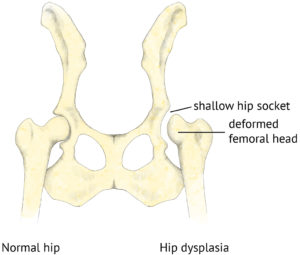 Hip Dislocations and Fractures
Hip Dislocations and Fractures
Dogs experiencing a hip problem could have several issues affecting the hip that may require surgery. Most commonly, these include fractures, dislocation, and hip dysplasia. The hip repair needed depends on the nature of the problem and often may be dictated by conditions found during surgery. Surgery using toggle pin fixation can be performed to replace a dislocated hip joint. We commonly recommend the femoral head and neck osteotomy (FHO) when the femur head is diseased and for hip dislocations in small dogs and cats.
Total Hip Replacements (THR)
Total Hip Replacements are considered the gold standard in the surgical treatment of severe hip dysplasia when pain has advanced to the point of no longer being medically manageable. A total hip replacement is a surgical way of replacing a femoral head and hip joint socket with an artificial replacement made of medical cobalt-chrome and polyethylene. Dog recipients of this surgical procedure are expected to return full hip function and continue to remain pain-free for the rest of its life.
Limb Deformities (ALD)
We see limb deformities in both cats and dogs, causing shortening or angulation of a limb, resulting in disability and pain. Often, malformations are found in young animals, as the correct growth of the bone is affected. Because of this, surgical intervention in juvenile patients is often needed. However, many times the limb deformities are not fully realized until adulthood, in which case, different techniques are employed.
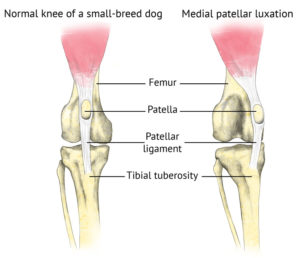 Patellar Luxation
Patellar Luxation
Medial patellar luxation is an orthopedic condition where the knee cap dislocates and becomes misaligned. The condition is both painful and a cause of chronic lameness and arthritis in both dogs and cats. Patellar luxation can also happen along with cruciate ligament ruptures and can even happen genetically in some smaller dog breeds like Yorkshire Terriers. Luxating patellas are often bilateral (both legs affected), but the procedure to correct a luxating patellar is routine with very successful outcomes.
Biceps Tenosynovitis
Biceps tenosynovitis occurs when the large tendon that spans the shoulder joint, called the biceps tendon, becomes injured, resulting in forelimb lameness. Common in working and active dogs, this injury can be a source of inflammation and discomfort if not treated. Diagnosis includes ultrasound, X-Rays, and a thorough orthopedic examination. Different treatment protocols can be employed depending on the dog and severity of the injury and range from surgery to other types of medical management.
Shoulder Instability
Shoulder instability is the result of tissues being stretched or damaged, resulting in instability of the joint. The shoulder joint itself is a shallow “ball-and-socket” joint, dependent on surrounding structures for stability. The joint is stabilized by several different tendons, ligaments, and the joint capsule. The diagnosis of this condition can often be challenging. It typically requires X-Rays, ultrasound, a complete orthopedic examination, and specific measurement techniques. Treatment will vary and be dependent on the severity of the condition. A treatment plan will be developed specifically for your dog by one of our veterinary surgeons based on your dog’s individual needs. Likely the recommendation will be non-surgical and include physical rehabilitation therapy.
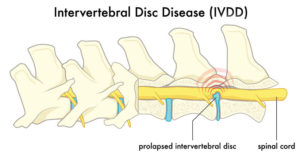 Intervertebral Disk Disease (IVDD)
Intervertebral Disk Disease (IVDD)
IVDD syndrome represents one of, if not, the most painful conditions a dog can develop which may respond best to surgical management. Extrusion, protrusion, and bulge can all cause the disc to put pressure onto the spinal cord and nearby nerve roots. This causes the neurological signs (e.g., weak or paralyzed legs, changes in skin sensation) and can cause extreme pain. In severe cases of extrusion, the center of the disc may explode out and hit the spinal cord so suddenly that this section of the cord is left concussed (damaged after being knocked), contused (bruised), or edematous (swollen).
If we determine your dog has IVDD, then how badly he or she is affected makes a big difference in the prognosis (how likely your dog is to feel better and to walk again after treatment). Our veterinarians at the Animal Clinic of Billings and Animal Surgery Clinic are here to help guide you through all of your options and plan the best course of action for you and your canine companion.
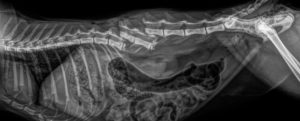 Advanced Spine and Neck Procedures
Advanced Spine and Neck Procedures
When a dog or cat fractures it’s spine, the vertebral bones of the spine break or come apart from each other; in other words, they dislocate or luxate. A broken spine usually occurs as a result of a significant injury. This could include falling out of the back of a moving vehicle or being hit by a car, and unfortunately, can be combined with other injuries to the chest, abdomen, and limb fractures. We do see occasional cases where the bones in the spine may fracture without a traumatic incident because a condition such as a tumor already weakens them. When vertebrae break or dislocate, in turn, they often injure or damage nerves and even the spinal cord. When the spinal cord is compressed or compromised, it affects nerve function and can lead to everything from slight weakening to paralysis. Spinal surgery aims to re-align and stabilize the affected vertebrae. The procedure most often involves placing screws or pins in the bones on either side of the fractures and securing them with either a plate or cement.
Anesthesia, anesthetic safety, and monitoring
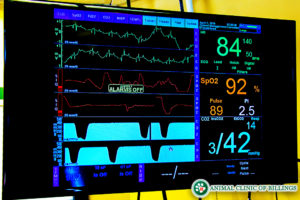
Uncertainty and fear of anesthesia are one of the most common reasons that pet owners neglect or are reluctant to give their dogs or cats necessary dental cleanings or other procedures. At the Animal Clinic of Billings and Animal Surgery Clinic, you can rest assured that your dog will be carefully monitored and very well cared for before, during, and after undergoing anesthesia.
Anesthesia and monitoring are essential, integral aspects of every surgery we perform. Anesthesia is tailored to the individualized needs of your dog or cat based on a number of factors. These include the type of procedure, your pets preexisting conditions, blood test values, age, breed, and prior anesthetic experience — the more appropriate the anesthesia, the fewer side effects and the faster the recovery.
Before dogs and cats are anesthetized, your pet is given pre-medications to help sedate him or her. Pre-sedation to the anesthesia helps to ensure the animal experiences the least amount of pain and anxiety possible throughout the entire surgical process. Pre-medication is essential because it helps your pet recover from anesthesia, and has an overall smoother induction into it beforehand as well. In most cases, pre-medications also allow for the amount of anesthesia needed during surgical procedures to be reduced.
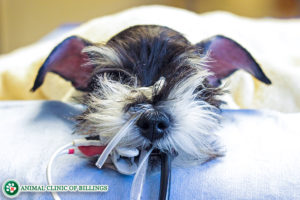 Once the pre-medication takes effect, an IV catheter is inserted directly into the dog or cats bloodstream. This allows us to keep your pet well hydrated with fluids during the surgical procedure, and rarely, if the need should arise, administer emergency medications. In addition to keeping your pet well hydrated, IV fluids help to maintain the function of the patient’s organs and control blood pressure while under anesthesia. Additionally, IV catheters provide quick access to the bloodstream and circulatory system, which enables us to administer additional medications, and prevent any complications that may arise.
Once the pre-medication takes effect, an IV catheter is inserted directly into the dog or cats bloodstream. This allows us to keep your pet well hydrated with fluids during the surgical procedure, and rarely, if the need should arise, administer emergency medications. In addition to keeping your pet well hydrated, IV fluids help to maintain the function of the patient’s organs and control blood pressure while under anesthesia. Additionally, IV catheters provide quick access to the bloodstream and circulatory system, which enables us to administer additional medications, and prevent any complications that may arise.
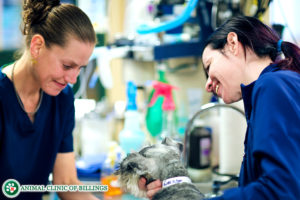 During anesthesia and surgery, your dog or cat is monitored by the veterinarian and veterinary technician, using our advanced monitoring systems. During major surgical procedures, we monitor your dog or cats oxygen level, respiratory rate, blood pressure, core body temperature, heart rate, EKG (electrocardiogram), and as needed, rapid blood gas determinations. Additionally, our surgical suite includes an artificial breathing machine (ventilator) if breathing assistance is needed. All of these combined efforts allow us to provide the best and safest possible outcome for your dog or cat. You can take comfort in knowing we provide the highest and most compassionate surgical care to our clients pets.
During anesthesia and surgery, your dog or cat is monitored by the veterinarian and veterinary technician, using our advanced monitoring systems. During major surgical procedures, we monitor your dog or cats oxygen level, respiratory rate, blood pressure, core body temperature, heart rate, EKG (electrocardiogram), and as needed, rapid blood gas determinations. Additionally, our surgical suite includes an artificial breathing machine (ventilator) if breathing assistance is needed. All of these combined efforts allow us to provide the best and safest possible outcome for your dog or cat. You can take comfort in knowing we provide the highest and most compassionate surgical care to our clients pets.
When it comes to broken bones or injured joints, orthopedic surgery is often times the most effective form of treatment there is. Our orthopedic surgeons can often return a canine’s limb, spine, hip, or joint to a near normal state.
Causes for badly broken bones and fractures
Bone fractures in dogs are commonly the result of external trauma that occurs in otherwise healthy pets. Their injuries are painful and stressful and often require the expenditure of time and resources to successfully manage.
We call the incidents that cause these injuries “accidents,” and they are. However, there are some common causes of these injuries that can be prevented:
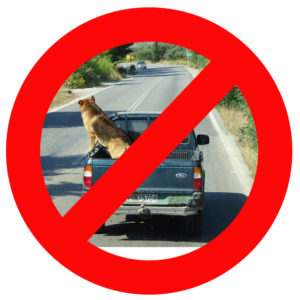
Tips for preventing broken bones and fractures
- Avoid placing untethered dogs in the backs of open pickups and don’t allow excitable dogs to ride in the cabs of vehicles with open windows. They will fall out. They will jump. They do get hurt.
- Do not pick up dogs by their front legs. Their legs are not handles, and bones can snap.
- Let the puppies do the walking: Toddlers and small children should not carry puppies because, like young humans, puppies squirm, and then they get dropped, and their bones break. It’s safer to let the pups walk on their own and better for their physical development.
- Blow the horn: Country dogs, especially ones who spend their lives outdoors, will seek out shade on hot days. Often, dogs nap under vehicles and trailers. Always check under and behind cars for pets (and children). Honking your vehicle’s horn is an effective wake-up call and a good practice before driving off.
If your pet breaks a bone – Get Proper Help Immediately!
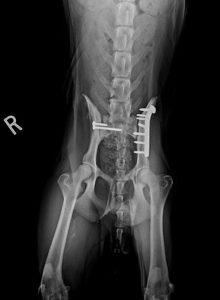 When accidents occur, and bone(s) are fractured see your veterinarian immediately. All bone fractures are not created equal nor is a good outcome assured no matter how well fracture patients are managed.
When accidents occur, and bone(s) are fractured see your veterinarian immediately. All bone fractures are not created equal nor is a good outcome assured no matter how well fracture patients are managed.
Follow the advice of your veterinarian – who always has your dog’s best interest in mind. Fracture-stabilization and fixation surgery may be needed for proper healing instead of a more straightforward cast or splint. If your veterinarian advises an operation, he or she is unequipped to perform and suggests a referral to a veterinarian that is so equipped, follow that sound advice.
Decisions and planning during early care are most important when dealing with significant injuries.
Animal Clinic of Billings fracture rehabilitation program
When post-op x-rays confirm stable enough fixation, a rehabilitation program may be started. During this period, the dog’s activities are gradually increased to stretch the surgery scar tissue and rebuild muscles.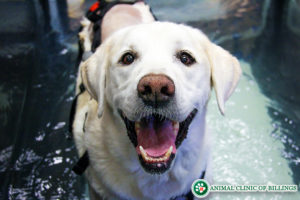
The degree of activity should progress with the dog remaining comfortable. Since increasing duration, not intensity is the goal, explosive movements, such as running, jumping, or playing, are not allowed during this period.
If your dog or cat has just had a major orthopedic surgery procedure, ask your vet for post-op rehab instructions.
We highly recommend incorporating physical rehabilitation therapy and laser therapy to your dog or cats post-surgery rehabilitation program in addition to our recommended home care.
We cannot emphasize enough how much of a difference it makes, both in recovery time and recovery outcome, when post-op patients are able to frequent our underwater treadmill and laser treatment center during the critical rehab months after surgery.
Learn more about our PRT Underwater Treadmill and Laser Therapy Treatment Center in Billings HERE.
Orthopedic Surgical Procedures
The Animal Clinic of Billings and Animal Surgery Clinic is equipped with a state-of-the-art surgical suite where our veterinary surgeons perform advanced orthopedic procedures.

Let our highly trained and experienced team of veterinarians and veterinary technicians help you keep your pet as happy and healthy as they can be.
Call the Animal Clinic of Billings to schedule your pets next wellness examination with us!
406-252-9499 REQUEST AN APPOINTMENT



